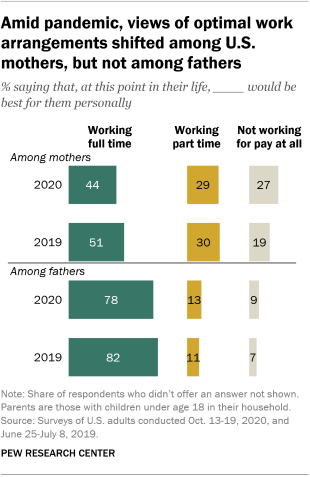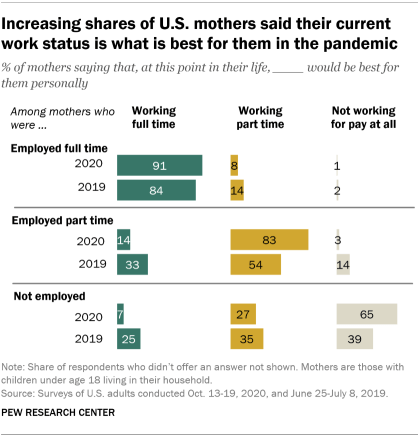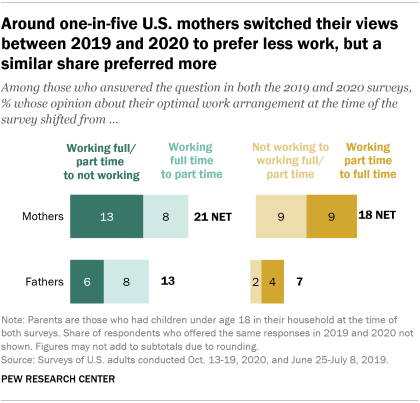The coronavirus pandemic has affected how schools and workplaces in the United States operate, and amid the disruptions, some parents have questioned whether working for pay really works for them.
Indeed, a new analysis of an October 2020 Pew Research Center survey of U.S. adults finds an increase in the share of mothers who said the best arrangement for them personally would be not to work for pay at all. About a quarter (27%) of mothers with children younger than 18 at home said this in the October 2020 survey, up from 19% who said so in a summer 2019 survey. The share of mothers who said it would be best for them to work full time dropped from 51% to 44% during that span, while around three-in-ten in both surveys said they would prefer to work part time.
There was no significant change in how fathers described their optimal work arrangements. In both the 2019 and 2020 surveys, around eight-in-ten dads said they would prefer to work full time. Much smaller shares said it would be best for them personally to work part time or not to work for pay at all.
Pew Research Center conducted this study to understand parents’ optimal work arrangements during the coronavirus pandemic. This analysis is based on two surveys: one conducted Oct. 13-19, 2020, among 10,332 U.S. adults and another conducted June 25-July 8, 2019, among 9,834 U.S. adults. All participants were members of the Center’s American Trends Panel (ATP), an online survey panel that is recruited through national, random sampling of residential addresses. This way, nearly all U.S. adults have a chance of selection. To further ensure that each ATP survey reflects a balanced cross-section of the nation, the data are weighted to be representative of the U.S. adult population by gender, race, ethnicity, partisan affiliation, education and other categories. Read more about the ATP’s methodology.
Here are the questions used for this report, along with responses, and its methodology.
The increase in the share of mothers who would prefer not to work for pay at all reflects, in large part, a change in the preferences of those who were not employed at the time. About two-thirds of mothers who were not employed in October 2020 (65%) said not working for pay was the best arrangement for them at that point in their life, up from 39% who said the same in 2019.
There was also a sharp increase in the share of part-time working mothers who said that work arrangement was best for them personally: In October 2020, 83% said they preferred this arrangement, up from 54% in summer 2019. A more modest increase was evident among full-time working mothers, a large share of whom already said in 2019 that that work arrangement was best for them personally (84% in 2019 vs. 91% in 2020).
While there have been some shifts in overall attitudes in what mothers see as the best work arrangement for them personally, looking at the same respondents over time shows a different pattern.
Among mothers who answered the question in both the 2019 and 2020 surveys, 21% gave an answer in 2020 that indicated a shift toward wanting to work less than they said would be ideal in 2019 (either from working full time or part time to not working for pay at all, or from working full time to working part time). At the same time, 18% indicated that their ideal work situation involved working more than they said was ideal before the pandemic (either from not working for pay at all to working full time or part time, or from working part time to working full time).
While the majority of fathers who answered the question in both surveys (80%) did not change their views, the shift among those who did was more pronounced in the direction of working less. Some 13% of these fathers either changed their answer from preferring full-time or part-time work to not working for pay at all (6% indicated this), or from preferring full-time work to preferring part-time work instead (8%). Just 7% of these dads indicated in 2020 that their ideal situation would be to work more than they said would be ideal in 2019.
Note: Here are the questions used for this report, along with responses, and its methodology.



